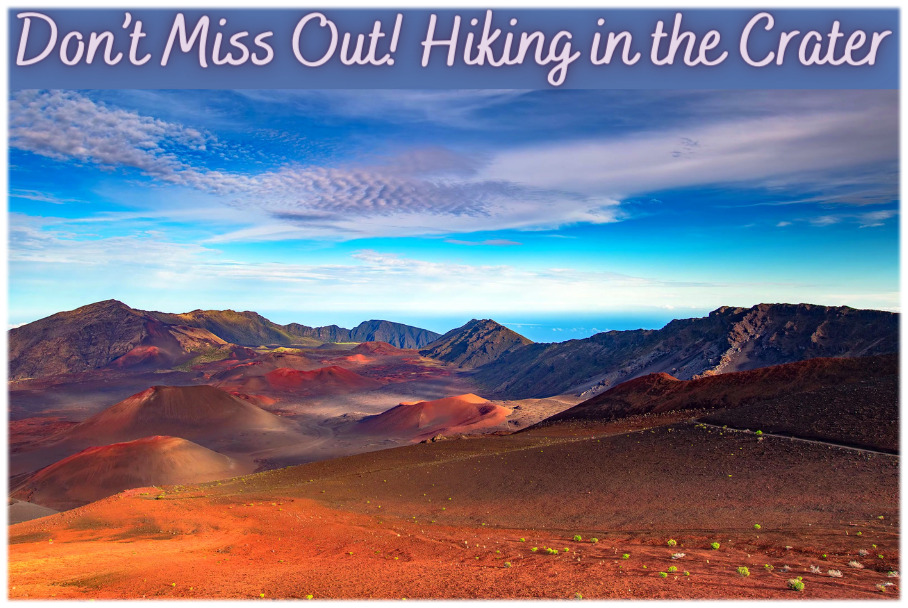 Haleakalā – The House of the Sun
Haleakalā – The House of the Sun
The mountain, the dormant volcano, and the crater have captivated human beings since they first gazed upon her beauty!
Mark Twain called sunrise from the summit “the sublimest spectacle I ever witnessed.”
Jack London wrote, “Haleakalā has a message of beauty and wonder for the soul that cannot be delivered by proxy”.
These legendary authors recommended that people take the 2,340-mile boat ride and then a 40-mile mule ride to the summit to experience this indescribable wonder!
Words can never convey the feeling or the energy one senses upon visiting this sacred mountain of Maui.
It is a spiritual experience. It has been Maui’s sacred place for Hawaiians since the beginning. You can read more in our blog: House of the Sun: Sacred, Mystical, and Rare.
To understand, you must stop, close your eyes and feel the wonder and joy surging up from within you.
The sheer magnificence of the physical beauty is worth the trip to the top.
There are only four ways to experience this sublime spectacle.
- 1,500 feet above the crater rim from a helicopter (Click HERE if this excites you!)
- Driving up for the spectacular sunrise (Reservations required!)
- On strictly controlled horseback trips
- On foot, hiking
You may prefer to be on foot via Trail Running. While hiking, I have encountered Extreme Athletes, running from the summit, through the crater to the Palikū side, down to sea level out of the Kaupo Gap. They were wearing shorts, t-shirts and carrying water bottles! This is not recommended!
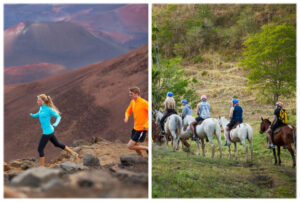
Haleakalā seems to call people to her.
The trail surfaces vary a lot when hiking down into the crater, from deep, soft, loose cinders and sand to steep rocky trails. Fortunately, they are all well-maintained.
The sun at the top is intense, and you can get severe sunburns on any exposed area of your skin. So lather up with sunscreen and bring plenty of water!
In 1916 Haleakalā became a U.S. National Park. This change allowed the development of trails, campgrounds, and even three very rustic cabins.
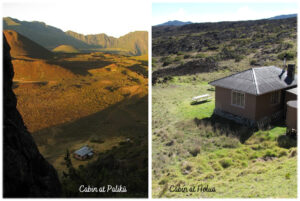
There are two main trails into the crater or park.
The trail starting near the summit is called Keonehe‘ehe‘e (Sliding Sands). It begins at the 10,023-foot elevation, whereas the other tail, Halemau’u, starts around the 8,000-foot level.
Many people who are going to camp or stay in the cabins will drop their car off at the Halemau’u trailhead parking lot and hitch a ride to the summit to begin their hike. The reverse parking order can mean a very long hike up the road when it’s nearly dark!
Walking DOWN the Kaupo Gap trail, mentioned above, ends way around the island’s desolate side. This hike is not for the faint of heart since it is so steep. You may lose a toenail or two if you’re not prepared. But there is glory and profound personal satisfaction in the experience and many have crossed it off their to-do list. Once is enough I have heard people say.
Why hike into Haleakalā?
There is just sooooo much to love inside the crater.
First of all, there’s that magical, sublime spiritual high you will feel as soon as you get there! Sacred space and deep, joyful silence.
The silence is so deafening that it will take you a while to realize the thumping you hear is your own heart!
Meanwhile, your eyes are bouncing around like a pinball, trying to capture the feast of visual beauty and magnificence – a multi-colored moonscape from millennia of erupting cinder cones.
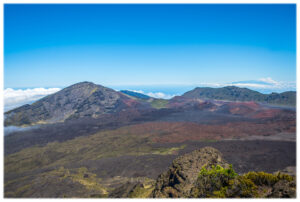
One of the Big Island’s mountains, Mauna Kea in the background
It is a painting, and the land is the canvas. There are a zillion colors of red, green, brown, black, and the sky’s brilliant blue. And, at night! The Sky! It is completely engulfed with stars and a full moon just out of reach.
When the clouds roll in and form around the crater’s rim, cascading continuously across the valley’s walls, it makes the colors even more mysterious and magical!
On unique occasions, sometimes on the Halemau’u trail, you may even get to see the Brocken or Mountain Spectre. You can see this when the magnified shadow of an observer or mountain casts upon clouds opposite the sun’s direction. It is a very unusual and beautiful sight!
For many hikers, plant and animal life is a big draw.
Before the National Park, cattle grazing nearly decimated this area. The National Park Service, mixed with hundreds of volunteers, has re-established many of the endemic plants over the past decades. Along with the plants, many rare and endangered endemic birds that rely on them have been slowly gaining in numbers.
If you have never hiked all the way into the crater, you will never know the otherworldly landscape. Arriving at the far, eastern end of the crater, Palikū awaits you. It is one of the most magical spots on Earth.
The Palikū area is just over 7,000 feet in elevation. Palikū receives more rainfall as it is closer to the frontline of the moisture from Hawaii’s tradewinds. Because of these elements, there are large, old-growth endemic Koa trees, giant ferns, and other beautiful endemic plants and grasses that you will not find easily in the other forests of Hawai’i.
Here’s where you will see ‘Apapane or a pair of I’iwi twittering near your tent or outside your cabin. You will see plenty of Hawaii’s state bird, the Nēnē.
Read more about Hawaii’s native bird population: START NOW
Another sweet feature of Palikū is a fenced pasture by the Park Rangers’ cabin. This is where the horses are kept while the rangers are on this side of the crater. The deep green fields and verdant cliffs, coupled with the horses, are images of what dreams are made of.
Full Moon in Haleakalā
There is nothing more profound than full moon nights in the crater. It is not uncommon to plan an evening walk in from the top during a full moon.
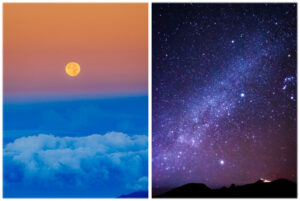
If you are spending a couple of nights, imagine it’s your second day in. You’ve taken a little day hike around the Palikū end of the crater and marveled at the Big Island so close by. You view Mauna Loa and Mauna Kea’s snow-capped peaks through the Kaupo gap in the crater rim.
On your way back to your cabin, around sunset, the full moon rises in the vast silence of the crater. The silence is only broken by two solitary Nēnē flying, chatting, one chasing the other, in a large loop overhead. In the background, the horses whinny – and you think: This must be heaven!
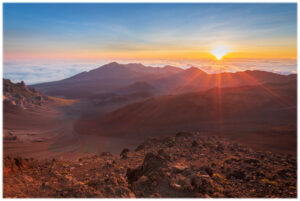
You may not be able to spend the night, but a walk through Haleakalā is an excellent thing to put on your Must Do list. If you can, plan it around the full moon. Your life will be changed forever. Those of us who have done it know that Mark Twain & Jack London were right!
Graphic Design by Sugandha Ferro Black
Photos courtesy of paid-for or free sources unless otherwise noted.
Crater Cabin Photos by Forest and Kim Starr- © CC BY 2.0/Flickr
